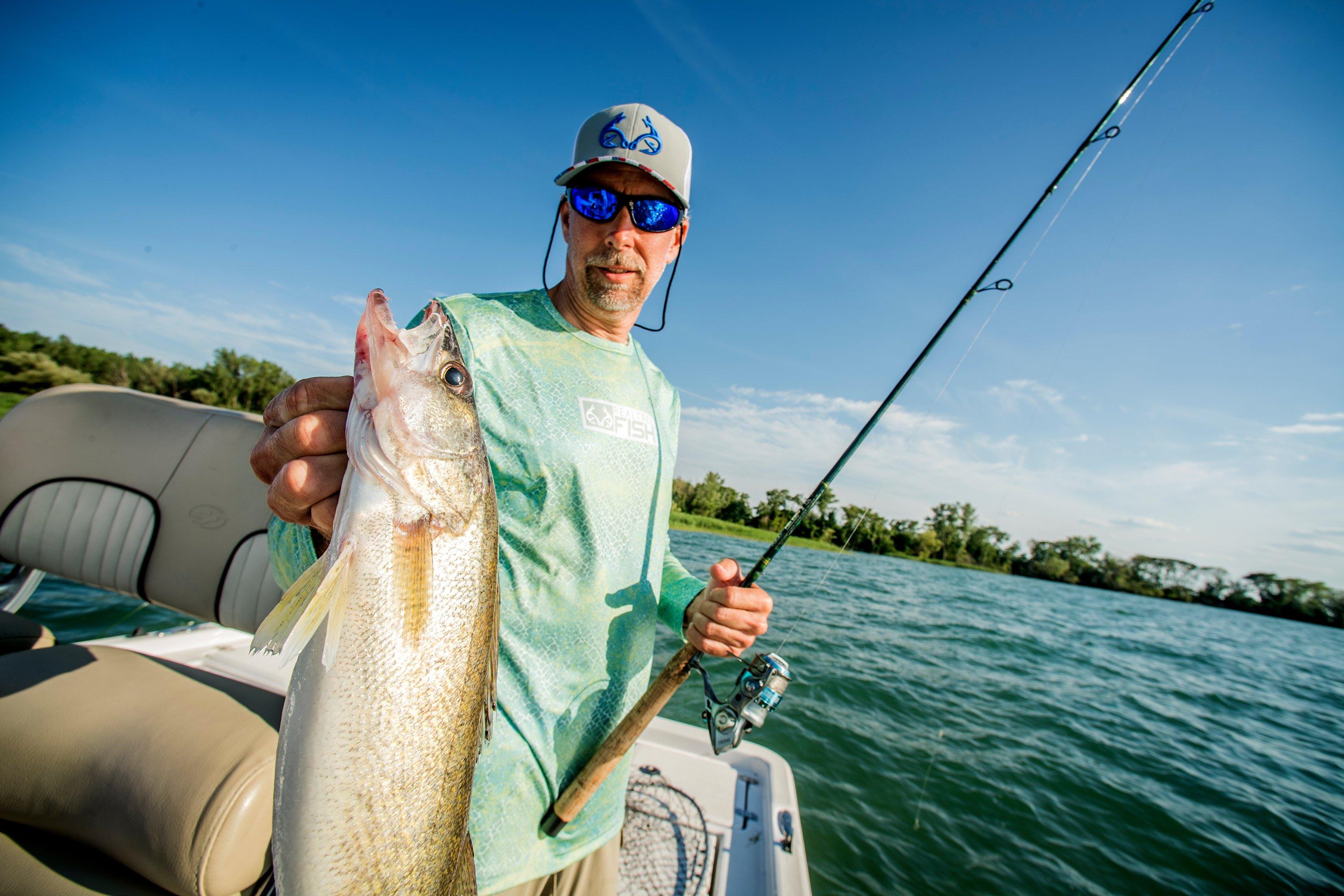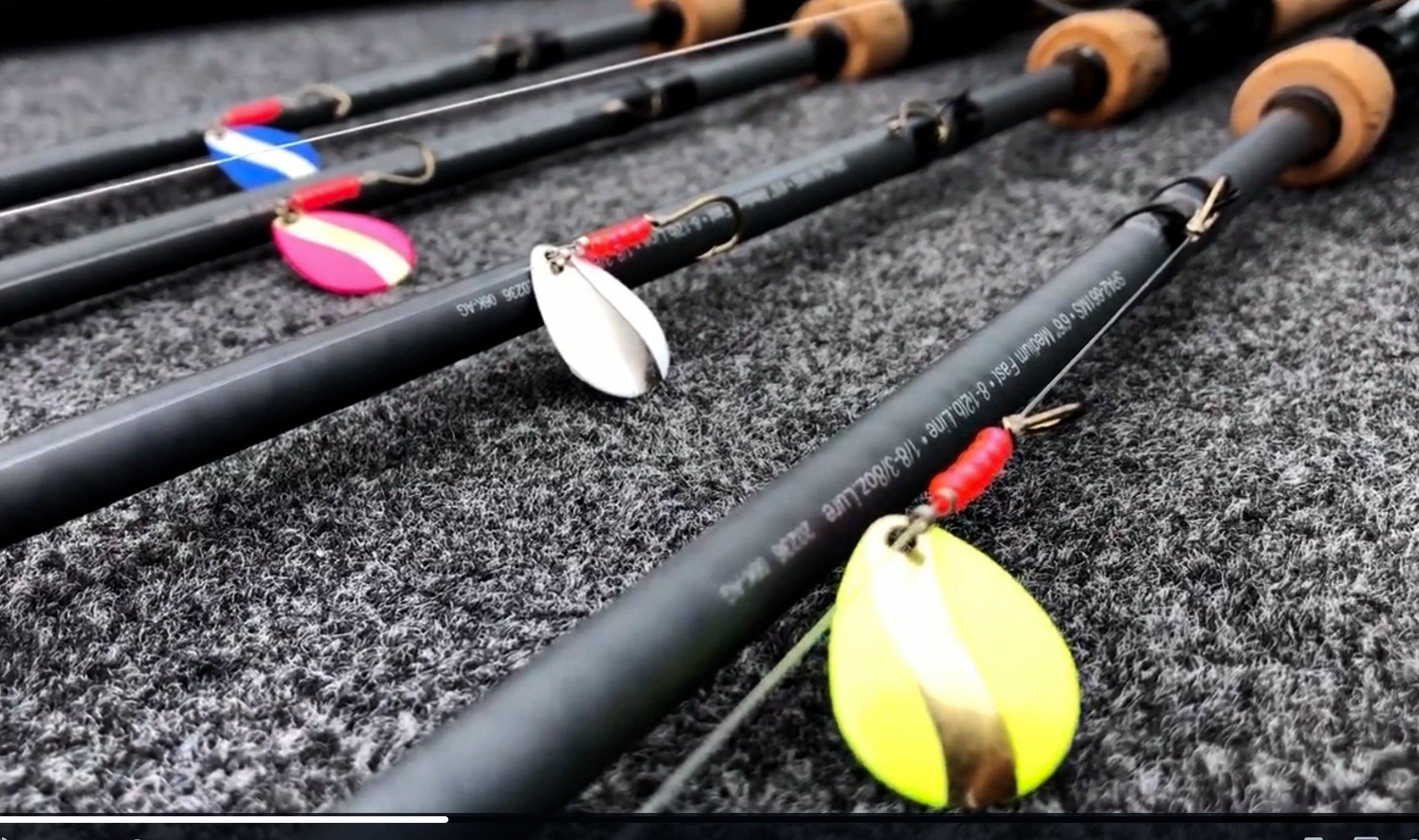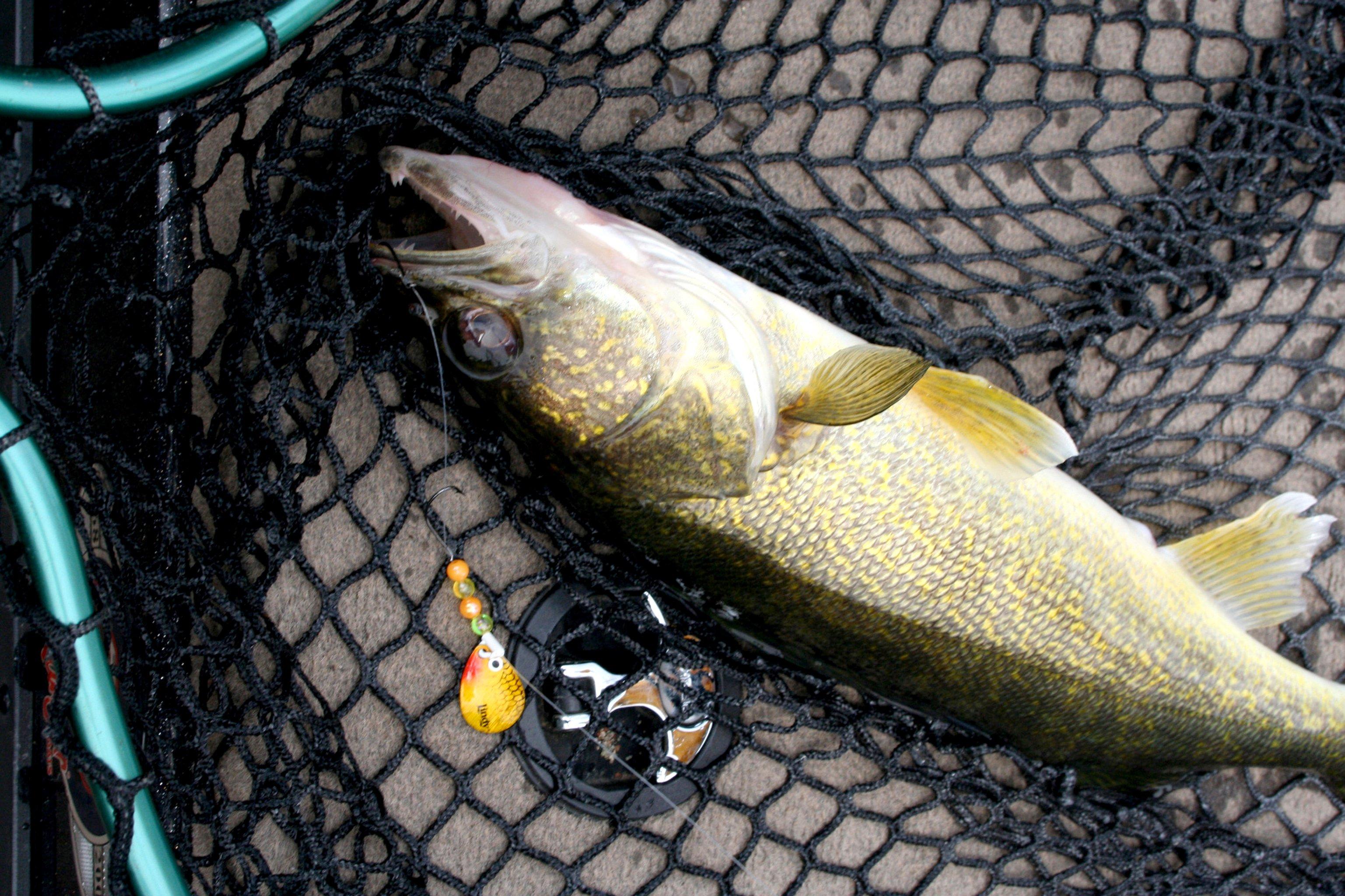What’s the best way to present your leeches, crawlers, and minnows? That depends on where and how you’re fishing
Live bait and walleye fishing just go together. While a bunch of fish are caught each year using artificial lures (in fact, most professional walleye tournaments are won using crankbaits), there’s just something pure about using natural baits.
It’s also incredibly effective. A generation ago, it was unusual to head to the lake without a bucket of minnows or a can of crawlers. Leeches — scorned by every other culture — are adored by walleye fishermen. Even crawdads catch a few.
There are more ways to rig live bait than there are baits themselves. Today, we’ll cut through the confusion to divulge the five best, ensuring you a stringer of fish when you go au naturel.

Live-bait presentations, from jigs and minnows in spring to crawler harnesses in the summer, work great for walleye fishing. Image by Lindy Fishing
1. Lindy Rig
Best Use: All-purpose drifting and trolling across North America
More walleyes have been caught on a Lindy Rig than any other live bait method, and for good reason. The system presents all kinds of baits very naturally, and it works all across North America.
It’s important to first break it down. The “Lindy Rig,” named after the Lindner brothers, walleye pioneers and TV personalities, is simply a walleye version of a leadered bottom rig, same as a Carolina Rig, Catfish Rig, or Fisherman’s Rig, depending on the region and species. The concept is simple: a sliding weight travels above a bead and swivel, which act as a stopper, and to the swivel is attached a leader of varying lengths and a hook, or hooks.
The sinker tracks bottom, or a designated spot in the water column, while the bait waves seductively in the rear. Objects, weeds, and snags are first encountered by the sinker, leaving the bait snag-free. A lively bait has the greatest appeal, making this rig perfect for minnows and leeches, but it’s also deadly with crawlers. A Lindy rig can be drifted or trolled, and it spends its life in the strike zone, rather than needing to be cast and retrieved.
It's important to designate that many of the rigs we see in walleye fishing are simply modifications of this system. There are “slip bouncers,” which are new weights designed to act like bottom bouncers (see below), but which slip like Lindy sinkers. There are contoured weights, colored weights, walking weights, even soft, weighted cloth bags that are used as sinkers and refuse to hang up.
All of these work on the same principle: the weight slides up and down the line while the bait trails behind. When a walleye hits, it feels no resistance from the sinker, thanks to the line sliding through.
Lindy rigs are extremely simple concepts, and popular for their efficiency. You can buy them pre-rigged or simply make your own. It’s best to use a small hook that ensures no restriction of the live bait. Utilize a sinker that’s heavy enough to get to the bottom, but that doesn’t drag roughly or hang in the weeds. Some anglers attach a spinner or small crawler harness on the business end for added appeal. Even floating jigs are occasionally employed to keep the bait up off a mucky bottom.

Crawler harnesses with a spinner work well with a variety of slow-trolling applications, including Lindy rigs and bottom-bouncers. Image by Lindy Fishing
2. Bottom-Bouncers and Spinners
Best Use: Big rivers and other deep-water areas with heavy current and numerous snags
Bottom-bouncers are lead weights fashioned around wire, weighing from 1/2 to 3 ounces, tied directly to the line. A leader is then tied from a swivel on the top of the weight, essentially setting up a three-way rig. Leader lengths vary, but about three feet is a good place to start. As the long wire of the bouncer touches down on bottom, the live bait trailing behind follows a bit higher. Here’s where a true crawler harness will add to the appeal. The spinning blades add flash, but also allow the harness to ride higher in the water and stay out of vegetation and snags.
Bottom-bouncer rigs are extremely effective around scattered clumps of weeds and weedlines. This is a trolling-one application (don’t try to cast one of these contraptions), and best pulled around 1 mile per hour. Braided lines work well for mainlines, but leaders should always be light fluorocarbon, like that of a Lindy rig.
While the Lindy Rig is a seductive, stop-and-go technique, bottom-bouncers keep constant motion, and a nightcrawler is about the best bait. At times, a half of a crawler works best. Always bait and rebait, even if you don’t catch a fish. Walleyes are suckers for freshly hooked or pinched nightcrawlers emitting seductive smell.
Keep moving when trolling a bottom-bouncer, downstream or downwind if possible. When you contact fish, quick turns can be made to enable an efficient, power-trolling technique. If your bouncer continuously drags up scum and weeds, go lighter, and let out more line.
Don’t Miss: ADVANCED TIPS FOR BASS FISHING BOAT DOCKS
3. Jig-and-Minnow
Best Use: Vertical fishing with sonar, or short-distance precision casting, especially in spring
In the North Country, the jig-and-minnow cleans house. While savvy pros today often substitute plastic, it’s tough to beat a sucker or chub on jighead. The secret of this rig lies in precision. With proper use of electronics and a trolling motor, a jig-and-minnow combo gets in the face of the fish, making refusal impossible. Sometimes, fish viewed on sonar can be seen coming up and eating the bait. Most fishing is done directly below the boat, or on a short cast.
The jig and minnow rig excels in cold water, from ice-out until mid-spring. That time of year, walleyes are reluctant to run down a crawler rig or trolled lure, making a more vertical approach most effective.
This rig is as simple as it sounds: a round-ball jighead matched with a minnow. On the Great Lakes, shiner minnows are often used, as they represent the bulk of the natural forage. Most other places, creek and river-run baits are preferred for their larger size and hardiness.
The minnow can be hooked through the head on a long-shanked hook, or the lips on a smaller hook. It’s not vitally important that the minnow remain alive, as the appeal is in the smell and taste.
In shallow water, around weed clumps or gravel bars, start with a 1/8-ounce jighead. Only increase the weight if necessary for depth or wind. When drifting in heavy wind or current, pick a weight the allows the bait to remain directly below the boat.
The debate over jighead color is never ending. Many old-school anglers religiously stick to natural colors like silver, gold, or black, while others swear by hot pinks and purple. It’s best to experiment as soon as the bite trails off.

Anglers have several good options for targeting suspended walleyes in open water. Image by Bill Konway
4. Slip Floats
Best Use: Slowly fishing productive areas, and targeting suspended walleyes visible on sonar
Most anglers never think of using a bobber when fishing for walleyes, but slip-float systems will often catch them when nothing else will. The technique is effective in water depths from 4 to 30 feet.
While bobber fishing can cover water in the wind, the slip float approach for walleyes is best for targeting individual fish seen on sonar or seining especially productive spots. Slip bobbers slide up and down the line, while a sizable weight below takes the bait down to the strike zone.
The set-up consists of: Bobber stop > bead > large slip bobber > sliding small egg sinker > bead > swivel > short leader line with 1/16-ounce jig head.
A few important details: the mainline should be braid, while the leader is made from light fluorocarbon. Choose a long, limber rod, as it handles slack line better and keeps things manageable.
Using the slip bobber stopper, adjust your length to present your bait right at, or just above, the level of fish seen on sonar. For bait, a live leech is tough to beat. If leeches aren’t available a small minnow works in a pinch, but it is more susceptible to being eaten by a bass. Choose a quality float intended for the technique, as they feature a brass grommet to allow line to flow easier through the float.

In general, live bait presentations should use small-diameter, fluorocarbon leaders. Image by Lindy Fishing
5. Erie’s Weight-Forward Spinners
Best Use: For casting to suspended schools of walleyes that are on the move in open water
Many walleye fishermen will never use a weight-forward spinner, but these unique lures have accounted for literally tons of fish due to their effectiveness on the greatest walleye lake in the world.
Every serious walleye fisherman knows that Lake Erie rules them all. Yet this massive fishery is unique in that it features little to no vegetation, and walleyes eat a variety of food sources, most often open-water baitfish like shad, shiners and white perch. Most times, Erie’s eyes are suspended in the middle of the water column based on temperature and light, and on the move.
For these reasons, a bunch of walleye fishing on Lake Erie is done using depth-controlled methods of trolling hardbaits. But the old-school captains still toss weight-forward spinners with tremendous results.
Originating in the late 1970’s, weight-forward spinner fishing started with the first commercial lure, the Erie Dearie. This bait combined a spinning blade with a long-shanked hook carrying a night-crawler, kind of an oversized inline spinner holding a walleye’s favorite meal. Anglers found that the combination of flash, vibration, and scent was more than the lake’s walleyes could stand.
Fast-forward 50 years, and the Erie Dearie is still catching them, along with other regional favorites like Tom’s Lures and the Parish Pea. All rely on the same principle of getting a bait down where the walleyes live by casting out, counting down, and retrieving in a pull-and-reel process. This technique excels with a steady-drifting boat, and most strikes come on “the swing” where a lure swings behind the angler, beginning to drag. A special flash or vibration change triggers strikes.
I’ve found that weight-forward spinners work on a variety of waters outside of Lake Erie when fish are suspended. They’re wildly fun to fish, as strikes are bone-jarring. A downside is the weight-forward spinners’ equal appeal to big channel catfish — unless, of course, you enjoy catching big channel catfish, too.
When rigging bait, always use a half of a night crawler, leaving the lure fairly straight. Hook on with a ball-bearing snap swivel to prevent line twist, and rig directly on thin braided line. Cast using a 7-foot, medium power spinning outfit.
Got bait? You’ll need some to consistently catch walleyes. Trust these five rigs to deliver it correctly, and be on your way to a limit of the North Country’s favorite fish.
Don’t Miss: SUMMERTIME CREEK FISHING FOR WHATEVER WILL BITE










